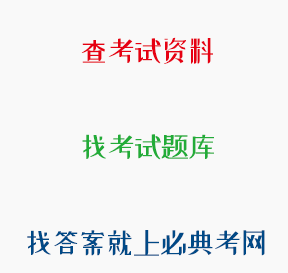正确答案:
题目:根据题目要求完成下列任务,用中文作答。
PPT是英语教师常用的一种教学辅助工具,请简述PPT在语言教学中的两个优点(6分),列举英语课堂教学中使用PPT常见的两个问题(6分),并提出合理使用PPT的两条建议(8分)。
查看原题 查看所有试题
学习资料的答案和解析:
[多选题]美国人力资本理论的代表舒尔茨认为,教育对国民经济增长的贡献是20%。( )
解析:美国人力资本理论的代表舒尔茨认为,教育对国民经济增长的贡献是33%。
[单选题]请阅读 Passage 2,完成1~5小题。
Passage 2
IF YOU want something done,the saying goes,give it to a busy person.It is an odd way to guarantee hitting deadlines.But a paper recently published in the Journal of Consumer Research suggests it may,in fact,be true-as long as the busy person conceptualises the deadline in the right way.
Yanping Tu of the University of Chicago and Dilip Soman of the University of Toronto
examined how individuals go about both thinking about and completing tasks.Previous studies have shown that such activity progresses through four distinct phases: pre-decision,post-decision (but pre-action),action and review.It is thought that what motivates the shift from the decision-making stages to the doing-something stage is a change in mindset.
Human beings are a deliberative sort,weighing the pros and cons of future actions and remaining open to other ideas and influences.However,once a decision is taken,the mind becomes more "implemental" and focuses on the task at hand."The mindset towards 'where can I get a sandwich'," explains Ms Tu,"is more implemental than the mindset towards 'should I get a sandwich or not?'"
Ms Tu and Dr Soman advise in their paper that "the key step in getting things done is to get started." But what drives that? They believe the key that unlocks the implemental mode lies in how people categorise time.They suggest that tasks are more likely to be viewed with an implemental mindset if an imposed deadline is cognitively linked to "now" -a so-called like-the-present scenario.That might be a future date within the same month or calendar year,or pegged to an event with a familiar spot in the mind's timeline (being given a task at Christmas,say,with a deadline of Easter).Conversely,they suggest,a deadline placed outside such mental constructs (being "unlike-the-present" ) exists merely as a circle on a calendar,and as such is more likely to be considered deliberatively and then ignored until the last minute.
To flesh out this ideA.the pair carried out five sets of tests,with volunteers ranging from farmers in India to undergraduate students in Toronto.In one test,the farmers were offered a financial incentive to open a bank account and make a deposit within six months.The researchers predicted those approached in June would consider a deadline before December 31st as like-the-present.Those approached in July,by contrast,received a deadline into the next year,and were expected to think of their deadline as unlike-the-present.The distinction worked.Those with a deadline in the same year were nearly four times more likely to open the account immediately as those for whom the deadline lay in the following year.Arbitrary though calendars may be in parsing up the continuous fiow of time,humans parse their concept of time in line with them.
The effect can manifest itselfin even subtler ways.In another set of experiments,undergraduate students were given a calendar on a Wednesday and were asked to suggest an appropriate day to carry out certain tasks before the following Sunday.The trick was that some were given a calendar with all of the weekdays coloured purple,with weekends in beige (making a visual distinction between a Wednesday and the following Sunday).Others were given a calendar in which every other week,Monday to Sunday,was a solid colour (meaning that a Wednesday and the following Sunday were thus in the same week,and in the same colour).Even this minor visual cue affected how like-or unlike-the-present the respondents tended to view task priorities.
These and other bits of framing and trickery in the research support the same thesis: that making people link a future event to today triggers an implemental response,regardless of how far in the future the deadline actually lies.If the journey of l,000 miles starts with a single step,the authors might suggest that you take that step before this time next week.
What is the author's primary purpose in writing this passage?
Illustrating the key point in meeting a deadline.
解析:主旨题。本文主要阐述了按时完成事情的关键,B项不符合文意;C、D两项均是文章的某个信息,并不能全面地描述作者的意图。故本题选A。
[单选题]The sound of "ch" in "teacher" is________.
voiceless,post-alveolar,and affricative
解析:本题考查字母组合的发音。字母组合ch在单词teacher中发/t∫/的音。辅音有多种分类方式。从声带振动上来看,/t∫/为清辅音(voiceless);从发音部位上来看,/t∫/为齿龈后音(post-alveolar);从发音方式上来看,/t∫/为塞擦音(affricative)。
[多选题]简述知觉的基本特征。
[单选题]When________is produced.complete closure of the articulators is involved so that the air stream cannot escape through the mouth.
stop
解析:本题考查辅音的发音方法。发音时发音器官闭合,完全堵塞气流通道,解除时障碍突然放开,气流骤然冲出,就产生塞音( stop)。如/p/,/t/,/k/,/b/,/d/,/g/都是塞音。fricative“擦音”,affricate“塞擦音”,lateral“边音”。故本题选B。

 川公网安备 51012202001360号
川公网安备 51012202001360号